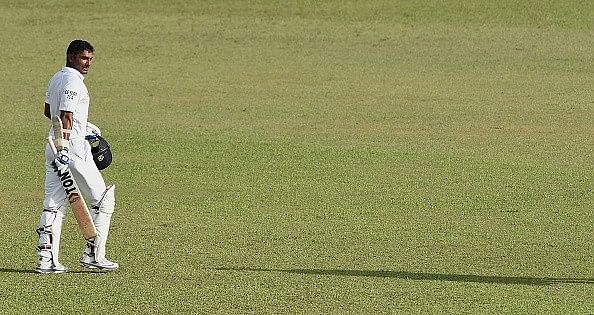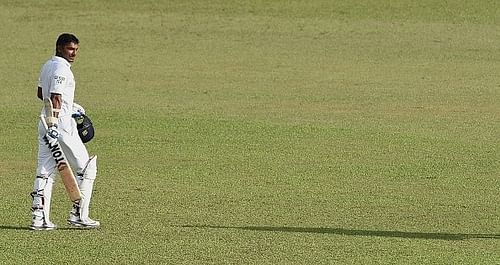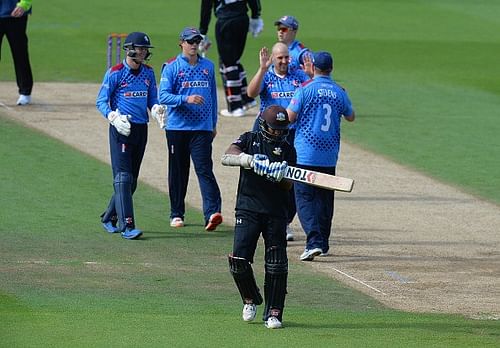
The possible reasons behind Kumar Sangakkara opting to play only two Tests in a series

The legendary Sri Lankan batsman, Kumar Sangakkara hung his boots at the end of the 2nd Test between India and Sri Lanka. Amidst all the raving encomium, there were few eyebrows raised about the veteran’s decision to play only two Tests in each series in what could now be considered as Sri Lanka’s cricket season.
This article would try to do an appraisal on the possible reasons that would have coerced Sangakkara to truncate the number of matches he played in the two-Test series.
Sangakkara’s longtime friend Mahela Jayawardene announced his retirement from Test cricket before the commencement of Sri Lanka’s two Test match series against South Africa, last year. His decision was expected to influence Sangakkara no end, but Sangakkara’s purple patch with the bat made sure none fantasized an end to Sangakkara’s Test career.
Experts opined that the southpaw should continue playing Test cricket for another two years, so that the new off springs could have a lamp of wisdom to guide themselves. But, during the second Test match versus Pakistan, which happened to be Mahela’s last test match and Sri Lanka’s last for that season, Sangakkara on his wave to the pavilion waved at the SSC crowd, which incited rumors of a possible retirement from Test cricket. But the former Sri Lankan captain dismissed any suspicion of a Test retirement, stating that it was ‘just a wave’.
However, things started going pear shaped when Sangakkara was refused a copy of the No Objection Certificate that was to be issued to him in 2013 but was held back by the then secretary of Sri Lanka cricket, Nishantha Ranatunga to entertain his ulterior motives. This resulted in heated emails being exchanged among Sangakkara, Sanath Jayasuriya - the then selector, team manager and some of the board members.
It was well known that Sangakkara had to endure a lot of hardships, humiliation and embarrassment at the hands of Nishantha Ranatunga and this incident, perhaps, pushed him to the periphery of his tolerance. Sangakkara may have thought enough was enough as he proclaimed earlier this year that he would no more play for Sri Lankan in any form of cricket after the World Cup.
This goaded the then selection committee into the frenzy as they by hook or by crook pleaded Sanga to defer his retirement plans. The Sri Lankan captain, Angelo Mathews said in an interview that he had almost gone down on his knees to beg Sanga not to leave. The minister of sports, Navin Dissanayake, then joined the bandwagon and begged Sangakkara to play for another two years. By that time, Sanga had already signed an agreement with Surrey to play for them during the English summer.

Fortunately, Sangakkara after lengthy discussions agreed to play for Sri Lanka until the month of August, playing only two Tests in each of the two series. By the time Sanga made up his mind to represent Sri Lanka in Tests until August, he had already signed for Surrey. So the possible reason would be that he was more interested in playing for the English county than playing for Sri Lanka.
This was the popular thesis posited by most media and was actively espoused by Dean Jones. But Sangakkara denied this during the media briefing which was organized to officially announce his retirement, claiming that counties provide international players with the provision to honor their national commitments.
It is noteworthy that, Sangakkara chose his home side Kandurata Maroons over his IPL side Sunrisers Hyderabad in the 2013 Champions Trophy tournament which resulted in him losing around a million US dollars. Furthermore, playing for a county side would not have yielded him any significant financial benefits. Thus, his commitment with Surrey cannot be propounded as a reason for not playing the last match of the two-Test series.
Lack of enthusiasm could be cited as another reason for Sanga not playing the last Test of the two series. The left-hander had already made his mind about his retirement and during the series against Pakistan and India he ostensibly looked lackadaisical, playing only for the sake of doing so. This lack of interest may have prompted him to opt to avoid the last Tests.
Another possible reason may be that Sangakkara would have wanted to give youngsters a chance. In various interviews, he spoke about how he didn’t want to hog a youngster’s place in the side and how his team didn’t need his services anymore.
Sri Lanka had previously unsuccessfully attempted the ploys of playing the veterans like Lasith Malinga and Muttiah Muralitharan only during important matches, allowing youngsters to play in low profile games. This decision of Sanga may have been a machination along these lines. By playing the first two games, if he can ensure that Sri Lanka gets an unassailable lead by winning the first two games, then the third would become a dead rubber making it the perfect breeding ground for a young batsman.
The reason why the team wanted Sanga’s continuous services was chiefly due to his experience. By playing first two Tests under his auspices, the youngsters would have got the know-hows about the oppositions and would have settled down into their respective roles in the team. So the third Test could effectively become the stage for youngsters to showcase what they had learned under Sanga.
Therefore, the only plausible reason for this cryptic phenomena seems to be that Sanga didn’t want to pilfer a young batsman’s position permanently in the team while playing a few tests for his country. The lack of interest which is the direct result of sated hunger for runs may have played a role. But these are merely speculations and only Sanga himself knows the precise reason for not playing the last test of each series. Perhaps, we need to wait for his memoir to get an insight into it.